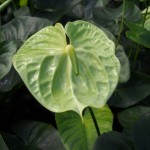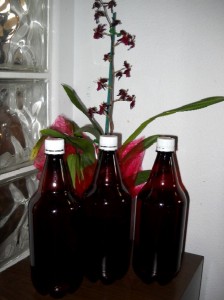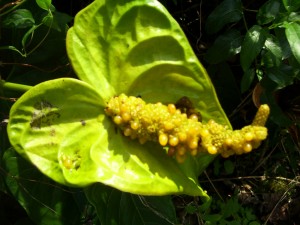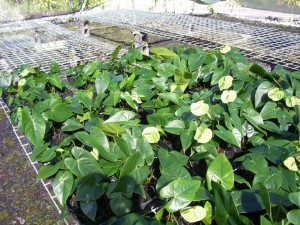Anthurium Gift Ideas
Anthurium flowers and anthurium plants from Hawaii make excellent gifts. Anthurium flowers are some of the longest lasting flowers around. Some varieties can last more than a month. Anthurium plants are sturdy and easy to grow, and they lend a great tropical feel to any room.
Hawaii has a long history with anthuriums. Anthuriums were brought here back in the late 1800s and the anthurium industry officially began around 1950, which is just a decade before Hawaii became the fiftieth state.
Complete anthurium arrangements can be ordered from most flower shops. But if you are willing to arrange the flowers personally, for the person you are giving them to, you can save some money by ordering loose flowers directly from farms here in Hawaii. They will arrive carefully packed in a box, separated by layers of shredded paper to cushion them while they are in transit. Make sure that they are shipped to you using either first day or second day air. Anything longer than this and they may not arrive in great condition. Also, make sure that you are home to receive them, when they arrive.
Anthurium plants can also be purchased from a variety of locations. Sometimes you can find them at a local garden shop or at a nursery that is near you. But you probably won’t be able to find the full set of varieties that you could find if you ordered them directly from Hawaii. Nurseries in Hawaii offer a greater selection, because many of the more interesting varieties were developed here.
As far as what cultivars to buy, if the recipient of your gift knows nothing about gardening, I would recommend sticking with Andreacola or Amnicola cultivars as they are easier to grow. But if the recipient has some gardening skills, an Andreaenum cultivar would make an excellent gift. It produces bigger flowers and comes in a wider assortment of shapes and colors.
Anthurium Colors: A Guide To Anthurium Flower Colors
Anthurium flowers from Hawaii come in many different colors. Here are a few of my favorite anthurium colors.
Purple is a newer color for anthuriums. Most of the colors you see today were developed after the 1940s and purple is even newer than that, it was developed sometime around 1980. Most purple anthurium plants produce a stunning tulip shaped flower in a very pleasing shade of purple.
White is an interesting color. If you take all of the colors of the rainbow and you blend them together you get white. White anthurium flowers were created by crossing a number of different anthurium species together. In fact, a white anthurium hybrid called White Lady is the product of four different species which were crossed together in 1987.
Pink is a very popular color and there are many varieties of pink anthurium. They can range in color from light pink to dark pink and they can be solid colored or mixed with other colors like white and green. You can even find then in standard, tulip, butterfly or obake shapes. Some of the pink amnicola hybrids are even blight resistant, so they are much easier to grow than other colors of anthuriums.
Green anthuriums were created by a grower named Calvin Hayashi in 1985, right here, on the Big Island of Hawaii. There are other varieties that may have some green in them or possess an off shade of green, but only the Midori is solid green. I believe that the Midori is one of the most innovative varieties as it was the first and still the only variety of anthurium that is completely green.
Red is the most popular color for anthuriums and there are a number of varieties of reds. Varieties include: Kozohara, Ozaki, Starlight Red, Princess Lily and New Pahoa Red. The Kozohara and Ozaki are among the older varieties and the other varieties are slightly newer. The major weakness of the red varieties is that many of them are highly susceptible to bacterial blight, though the University of Hawaii and other breeders have been hard at work at creating blight tolerant varieties.
Anthurium Andraeanum a.k.a. Andreanum
Anthurium Andraeanum is an extremely popular species of flowering plant from the Araceae family. There are between 800 and 1000 known species of anthurium, but Andraeanum which is also commonly spelled Andreanum is by far the most popular and most commonly grown species. Various Andraeanum cultivars form the core of the anthurium flower industry, which started back in the late 1940s in Hawaii.
Anthurium Facts
Family: Araceae
Genus: Anthurium
Species: Andraeanum
Plant Type: Herbaceous perennial
Zone: 11 to 12
Height: 1 to 1.5 feet
Spread: 0.75 to 1 foot
Bloom Time: Flowers freely
Sun: Part shade
Water: Medium
Maintenance: Medium
Uses: House plant, cut flower
Common Names
Anthurium, tail flower, flamingo flower, cresto de gallo, cockscomb, anturio and boy flower. But anthurium is the common name that is used most widely.
Common Misspellings
Antherium, anturium, arunthium, anthorium, anthiriums, antariam, antorlium, anthuriam, anthrurium, anthirium, anterium and antorium.
Noteworthy Attributes
These plants are native to Central and South America, however many of the original cultivars were initially developed in Hawaii. They produce 6 to 12 heart-shaped flowers a year in a wide assortment of colors. Plants grow to an average of three feet tall, though they can grow much taller in the proper environment. They produce heart shaped leaves that can range from 8 to 18 inches long. It flowers year round in tropical conditions and seeds are unlikely to be produced on indoor plants without manual pollination procedures.
Anthurium Care Guidelines
Outside of the tropics, it can be grown in most parts of the world as a potted houseplant. Proper anthurium care starts with using a very well-drained potting mixture. And remember to put a layer of pot shards, marbles or gravel at the bottom of the pot to further ensure good drainage. Bright light is required, but direct sunlight can burn these plants. They require consistent watering throughout the year and they do not go dormant during the winter. Ensure that they are not exposed to temperatures less than 60 degrees for any extended period. They require high humidity or frequent misting with water. Repot every two years and utilize a thin layer of sphagnum or peat moss on the surface to retain a little moisture.
Caution Poisonous
Anthuriums can be poisonous to humans and pets. They contain Calcium oxalate which can cause oral irritation and difficulty swallowing, so keep them out of reach of children and pets.
Solutions To Common Anthurium Problems
Dark Spots On Leaves
If you keep your plant in a cold location and the leaves of your plant develop dark spots, you should try moving it to a warmer area.
Leaves Are Turning Yellow And Withering
This can be caused by excessive exposure to sunlight. If your plant is in a very sunny spot, try moving it to a location that receives less sunlight.
Scale Insect Infestation
If your plant is attacked by scale insects, mix a mild solution of soap and water and use a soft cloth to wipe down the leaves of your plant.
Stunted Growth And Small Shriveled Leaves
This may be caused by a fungal infection that is affecting the roots of your Anthurium Andraeanum. Prevent this from occurring by using a well drained potting soil and being careful with your watering. If this has already occurred, try repotting into a well drained soil and trimming away diseased portions of the plant.
White Anthurium
White is an interesting color. When you take all of the colors of the rainbow and you blend them together you get the color white. White anthurium flowers were created by mixing a number of different anthurium species together. In fact, a white anthurium hybrid called White Lady is the product of four different species which were crossed together in 1987.White Lady is an excellent plant to grow at home, because it makes a great potted plant. It is a very compact plant so it is capable of growing in a small pot in a small amount of space. It is also a very hardy plant and in fact it also demonstrates resistance to the bacterial blight. If treated well, it will produce six elongated tulip shaped flowers a year. These lovely flowers will acquire a slight hint of pink as the flowers mature. If you put these flowers into a vase, they will last up to 25 days.
Other white and off-white varieties include: Pua Kea, Ellison, Sister Grace and Limelight. Most of these types of flowers fall into the standard anthurium family as opposed to the tulip anthurium family like White Lady. Standard anthuriums are medium sized flowers that are heart shaped, while tulip anthuriums are smaller and of course tulip shaped. Tulip anthuriums are usually hybrids of the anthurium amnicola species, while standard anthuriums are generally hybrids of the anthurium andraeanum species.
White anthurium care is very straightforward. Put them near a sunny window, but do not allow them to receive full-strength sunlight or they will get sun burned. Make sure that they are kept at a temperature of 70 to 80 degrees. Water them regularly, but make sure that their soil is always well drained. Apply a small amount of slow release fertilizer once or twice a year. And that is pretty much all there is to it.
White anthurium flowers can be arranged in a number of ways. A simple arrangement could consist of 6 to 12 flowers all by themselves. More complex arrangements could consist of pinks and whites; or whites, pinks and reds. You could also mix them with other flowers. They go really well with orchids and green tropical foliage. If you really want to push the envelope, you could arrangement them with red anthuriums, lilies and roses, as well.
Purple Anthurium: An Anthurium Andraeanum and Amnicola Hybrid
Purple anthurium plants produce a stunning tulip shaped flower in a very pleasing shade of purple. As you may already know, originally, anthuriums didn’t come in very many colors. In fact most of the colors that you see today were developed after the 1940s. Purple is a color that is even newer than that. I believe that it was first developed sometime after 1980.
Purple Anthurium Origins
This flower was created by crossing anthurium andraeanum with amnicola to produce a hybrid named andreacola. Andreacola appears to have inherited the best traits of both of its parent species. From the amnicola it received its ability to produce tulip shaped flowers, its compact size and its resistance to the bacterial blight. From the andraeanum it received an ability to produce larger flowers and a multitude of colors, which, of course, includes purple.
Tulip Anthurium Cut Flowers
As a cut flower, they are perfect for smaller arrangements because they are slightly smaller than regular anthuriums. They have a great vase life and will last for several weeks. They look great when arranged with pink and pastel green anthuriums or when arranged with white orchids. Another thing that sets this variety apart is that sometimes these flowers will have a very pleasant scent. Just about all other anthurium flowers are unscented, but sometimes these flowers have a great fragrance.
Excellent House Plants
They also make excellent houseplants. They are more compact than other varieties so they take up less space in your house. Furthermore they are even hardier than other varieties, so they are even easier to care for. The fact that they are blight resistant is another positive factor. This makes for one less thing that you have to worry about.
Ordering Tips
If you do decide to order one of these plants, try to order during a time of the year where the average daily temperature is 70 degrees and the range of temperatures is narrow. Temperatures that are too hot or too cold, during shipping, may harm these plants while they are in transit.
Taking Care of Your Purple Anthurium Plant
After you order, aim to have a spot for your new plant set up before it arrives. The ideal location has a number of characteristics. First, the temperature should be near 70 to 80 degrees and it should not fluctuate much from this ideal. Second, this spot should be well lit but it must not receive direct sunlight. Direct sunlight can burn your plant. Third, high humidity is ideal, but you can compensate for low humidity by misting your plant with water every day.
As far as caring for your new plant, the main this is: remember to water it regularly. Ideally, you should water it everyday. This is what wild anthuriums are accustomed to receiving in the rain forest, but you must also make sure that all of the water drains away from the roots of your plant rapidly. If the roots remain in contact with water for too long they can suffer root rot and this can harm your plant.
Green Anthurium aka Midori Anthurium Plants
So far no one has been able to breed a blue anthurium, though I am sure that if scientists put their minds to it they could do so, much like they have done to create blue roses in the lab. As of now, the closest we can come to blue is the color green, at least green is next to blue in rainbows. Green anthurium plants are also known as Midori anthuriums.
We sell large green anthurium flowers for $3.50 per stem and plants for $29 per top cutting.
Click Here To See Our Catalog.
Green Anthurium Origins
This variety was created by a grower named Calvin Hayashi in 1985, right here, on the Big Island of Hawaii. I believe that the Midori is one of the most innovative varieties as it was the first and still the only variety of anthurium that is truly green. There are other varieties that may have some green in them or possess an off shade of green, but only the Midori is just solid green.
Vase Life
Another trait that makes this variety special is its vase life. It has one of the longer vase lives of all of the anthurium flowers. It can last a month or even more in a vase, if handled properly after being harvested. Proper handling consists of trimming half an inch off the bottom of their stems as soon as you receive them, placing them in clean water and making sure you put them in a room where the temperature stays close to 70 degrees.
An Interesting Phenomena
One interesting thing you’ll notice if you buy a green anthurium plant is something that growers actually try to avoid. When these flowers are left on the plant for too long, they start to change color. Growers obviously do not want to see this happen, but if you are like me, you’ll find that this actually makes them look even more interesting. If you leave the flowers on your plant, rather that putting them in a vase, you’ll find that they will develop copper colored highlights that contrast nicely with their regular smooth green surface.
Midori Anthurium Care
To keep your Midori alive, the number one rule is: don’t forget to water it. If you remember only one thing from this article, I hope that you remember that. These plants need to be watered regularly; they come from rain forests, after all. Next, after watering, make sure that all excess water is drained away and removed from the pot. If water is left in the pot it can cause the root system of your plant to rot away. Always, keep your plant in a room with a stable temperature, around 70 degrees. You can put it near a window, but block direct sunlight with a thin, gauzy curtain, so that your plant can receive filtered sunlight to avoid burning. Finally, give it a small amount of slow release fertilizer before the growing season in your area.
Hawaiian Drinks: A Brief Guide To Hawaii’s Tropical Drinks
Hawaii is home to beautiful beaches, active volcanoes and beautiful flowers like ginger and anthurium flowers. In Hawaii, you can also find several drinks have become closely associated with the islands. Few people fail to think of Mai Tai’s or Blue Hawaii’s, when the drinks of Hawaii are mentioned. But Hawaii also offers a special type of coffee and an exotic drink called kava. Here are a few of my favorite Hawaiian drinks.
Mai Tai
Almost everybody who visits Hawaii has heard of the legendary drink called the Mai Tai. But did you know that this drink wasn’t invented here. It was invented by a man named Donn Beach who owned a restaurant in California. Beach’s recipe consists of rum, orange curacao and orange juice. Beach seems to have the perfect surname for a man whose drink is sipped on the beaches of Hawaii.
Kona Coffee
A man named Samuel Ruggles brought the first coffee plant to Kona in 1828. Kona’s unique weather and fertile soil produces a coffee that surpasses nearly all other coffees in the world. The only comparable coffee outside of Kopi Luwak (which is not for the squeamish) is probably Jamaica’s Blue Mountain coffee. Kona coffee is grown on over eight hundred farms that are located in the districts of North or South Kona. Only coffee cultivated in these two districts can be called Kona Coffee.
Blue Hawaii
The Blue Hawaii was created by Harry Yee in 1957. Yee came up with the Blue Hawaii, which is a combination of vodka, rum, blue curacao and pineapple juice, after being asked by a product sales representative of the Bols Company to create a drink featuring their new Blue Curacao liquor. Obviously, it was a big hit. The Blue Hawaii, with its signature blue color, has become a popular drink in Hawaii.
Kava
Kava is grown all over the pacific. Early polynesian voyagers introduced kava to Hawaii and have been having it for centuries. Kava appears to calm the mind and body, and also seems to foster sociability. But be forewarned, most people who try kava for the first time say that it is one of the most horrible tasting drinks they have ever tried.
Mauna Kea Observatories
Did you know that the largest astronomical observatory in the world is located in Hawaii? Well it is, the summit of Hawaii’s Mauna Kea Mountain is home to thirteen telescopes. The total light gathering capacity of these telescopes is fifteen times greater than the Palomar telescope, which used to the largest telescope in the world. Mauna Kea is home to several of the largest telescopes in the world, including the largest optical telescope, the largest infrared telescope and the largest submillimeter telescope.
Mauna Kea, which means “white mountain” in Hawaiian, is aptly named as it is covered in a thick white blanket of snow for most of the year. It is the highest point in the Pacific and it is the highest island mountain in the world, measuring 32,000 feet from its base on the ocean floor to its summit. This is higher than Everest, which is 29,000 feet.
Mauna Kea is the ideal location for setting up telescopes to look deep within the universe. The air above it is some of the driest in the world. Clouds are almost never an issue as it has an incredibly high number of cloud free nights, which allow uninterrupted observation. It also has a tropical inversion layer which traps pollutants and moisture thousands of feet below the summit. This ensures that the summit has extremely clear air, which is important when gazing far into the universe.
The actual telescopes are off limits to the public, but you can still visit the summit. Be prepared for extremely cold and windy conditions. Also, you must be prepared for the altitude which is close to 14,000 feet. Altitude sickness can be a big issue for some people.
You should stop at the Onizuka Center before proceeding to the summit. The center is located at an elevation of 9,300 feet and stopping there will give your body a chance to acclimatize to the elevation. At the center you can see exhibits about Mauna Kea and its observatories.
Anthurium Flowers and Plants
ANTHURIUMS are one of the most beautiful flowers in the world. ANTHURIUM FLOWERS are produced by ANTHURIUM PLANTS, which are members of the genus ANTHURIUM. This genus consists of over eight hundred ANTHURIUM SPECIES and hybrids like OBAKE ANTHURIUM. ANTHURIUM CARE is easy and consists of finding the right place to put them and watering them properly. HAWAII is one of the first places in the world to grow anthuriums commercially.
Anthurium Propagation: Seeds, Cuttings & Tissue Culture
There are three ways to propagate anthurium plants: you can take cuttings; you can grow them from seeds; or you can tissue culture them. Cuttings are easy for anyone to do. Seeds are a little more difficult to do, and tissue culture is generally reserved for scientists in labs or really advanced anthurium cultivators.
Anthurium Cuttings
Cuttings are by far the easiest way to propagate your anthurium plant. The best part about taking cuttings is that the plants you produce will look exactly the same as the parent plant. First, you must wait until your plant is big enough to allow a cutting to be taken. Generally you’ll want to see at least four nodes, or sets of leaves and roots, before taking a cutting. Once your plant is big enough, cut it in half, so that each portion has at least two nodes. Leave the base of your plant in its original pot and it will generate new growth. Then put the top cutting into a new pot, water it regularly and it will keep growing, too.
Anthurium Seeds
Anthurium seeds are another way to propagate your plant. However it is a much more difficult process and takes a lot more patience. The stigma and stamen of these flowers are active at different times, so if you want to produce seeds you will have to store pollen in the freezer or have two flowers at different stages of development. So the first thing you have to do is gather pollen. Use a paint brush to scrape pollen off the stamen and into a vial. Keep this vial in the freezer until you see that the stigmas are ready to be pollinated. Once you have a flower with receptive stigmas dust a little pollen over it. Next you will have to wait for approximately a year for seeds to be produced.
Anthurium Tissue Culture
Tissue culture is almost exclusive done within the confines of a lab, with the exception of really high end hobbyists and growers. It is best left to commercial growers because it is very expensive and is generally used when one wants to produce thousands of genetically identical plants. So how does an anthurium farmer tissue culture an anthurium plant?
First, the anthurium farmer chooses an ideal specimen. This specimen will be replicated thousands of times, so a lot of time and effort is put into choosing the very best specimen available. Once this precious plant is selected, the farmer takes it to a lab.
In the lab, a scientist confirms that the specimen is healthy and then chops off a piece of it. Then the scientist will sterilize the sample and put it into a beaker that contains an agar based gel. This beaker also contains special plant hormones that trigger the sample to form a callus, which is an undifferentiated mass of plant cells.
The callus is divided into many portions and then allowed to grow once more. This method is replicated multiple times. Once sufficient material is created, the calluses are moved to a growing media which contains plant hormones that cause the undifferentiated cells to transform into roots and shoots. This causes hundreds of plantlets to sprout from every callus.
After the plantlets have grown sufficiently, they’re transplanted into brand new flasks to mature further. Once they have reached a size where they can survive in open air, they are removed from the beakers and transferred into pots. These new plants are allowed to mature in the tightly controlled conditions of a plant nursery for a while. Then, after they have adjusted to growing in open air, they’re returned to the farmer for transplanting into his fields.











